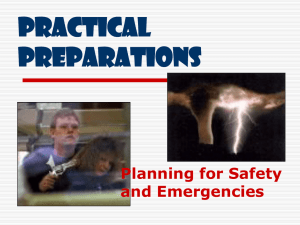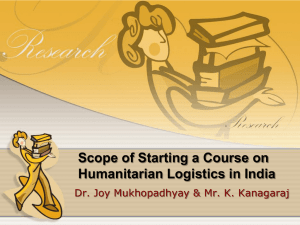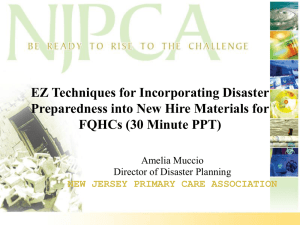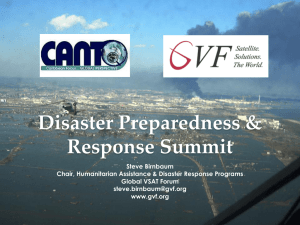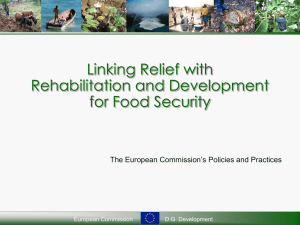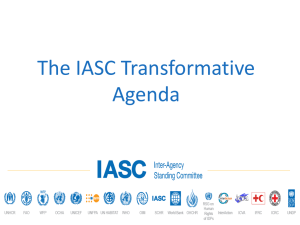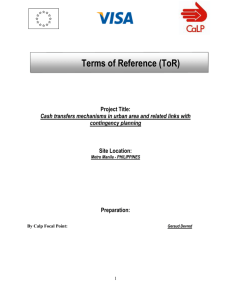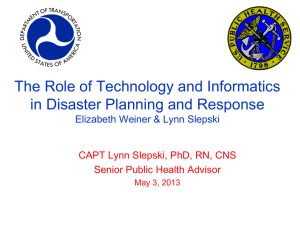Emergency planning - Missions
advertisement
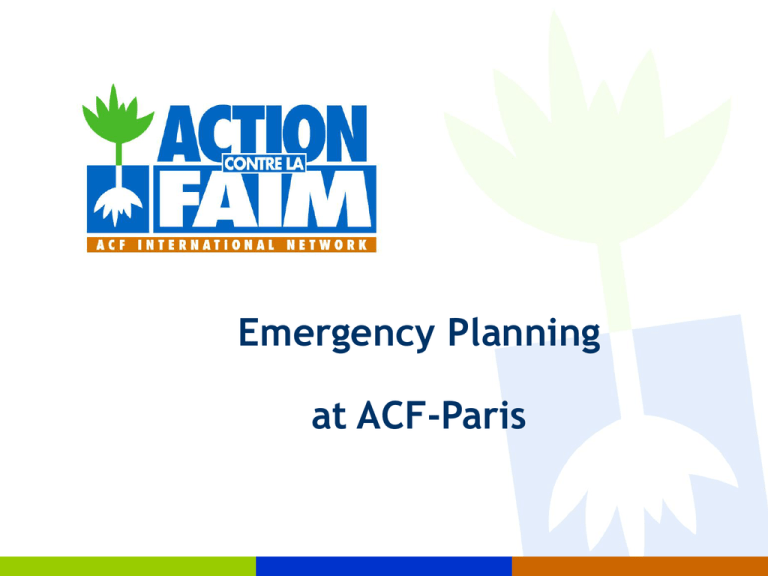
Emergency Planning at ACF-Paris Amuse-bouche Ask yourself the following questions: What could be emergency planning ? Why would ACF need to do it ? Amuse-bouche If you lack inspiration to answer the previous questions, here are more questions: If another flood would occur tomorrow in your country... What would be the impact on the people affected? What actions would be required to meet humanitarian needs? How would organisations work together? What resources would be required? What could ACF do to be better prepared next time? Amuse-bouche Answers: What could be emergency planning ? Emergency planning is asking yourself before any disaster occurs: What kind of disaster could happen? What would be the impact on the people affected? What actions would be required to meet humanitarian needs? How would agencies work together? What resources would be required? What could organisations do to be better prepared to disasters?, etc. Why would ACF need to do it ? Emergency planning enables to plan what could happen if a disaster occured and how ACF would respond to it. When disaster finally occurs, the response is already prepared and ACF can better meet humanitarian needs. 1. What is emergency planning? Emergency planning involves identifying, strengthening and organising resources and capacities so as to reach a level of preparedness for timely and effective response to a potential disaster. This includes: Determining roles and responsibilities; Developing policies and procedures; Identifying and developing generic tools for response (e.g. the use of National Disaster Response Teams (NDRT), information management, etc.). IFRC Disaster Response and Contingency Planning Guide Emergency planning levels Five existing level of Emergency planning (EP) Global EP Organisation EP Inter agencies EP National/Regional EP Community EP Common emergencies: Hurricanes/cyclones Famine Floods Economic collapse Earthquakes Internal conflict/War Droughts Displacement/forced migration Crop failure Border closures Volcanic eruptions Food aid pipeline breaks Tsunamis Peace Landslides Prepositioning Epidemics Logistical bottlenecks 1. What is emergency planning? EMERGENCY PLANNING IS NOT CONTINGENCY PLANNING Emergency planning is preliminary in nature, based on educated assumptions of risks and hazards, and does not address specific disaster scenarios – as is the case for contingency plans. Once a disaster occurs, plans must then be monitored, evaluated and adapted to the specific situation. Contingency planning focuses on specific disaster events with a high risk of occurrence and linked to high levels of vulnerability; they identify in detail the potential humanitarian needs, actions, resources, constraints and gaps. Although both emergency and contingency plans include similar steps, the perspectives from which they are written and the level of detail required are different. IFRC Disaster Response and Contingency Planning Guide 2. Why emergency planning? The fundamental reason for emergency planning is to improve the efficiency of a humanitarian emergency response. Emergency planning helps humanitarian actors to plan while there is time. Experience demonstrates that emergency planning can enhance the effectiveness, appropriateness and timeliness of response to emergencies. 2. Why emergency planning? There are many good reasons why NGO’s should do emergency planning: Time Relationships Effectiveness Deal with anticipated problems before the onset of a crisis Put in place measures that enhance preparedness Establish relationships with partners Develop shared understanding of common challenges Clarify roles and responsibilities Strengthen coordination mechanisms Enhance the quality of humanitarian response! Identify constraints to effective response actions Focus on operational issues 9 3. How to do emergency planning? Preparedness Elaboration of the plan Disaster Implementation of the plan Emergency planning steps Emergency planning is a tool to anticipate and solve problems that typically arise during humanitarian response: Analyse potential emergencies Analyse potential impact Establish clear response strategies Implement preparedness actions Example: Example: Example: Example: Due to unusual weather patterns, Country X is at risk of large scale flooding this year. Up to 250 000 people would be displaced from their homes and 55% of domestic crop production would be wiped out. 1. Temporary settlement site identification and design - Determine communication channel during emergency 2. Protecting the most fertile crop lands - Design of a contingency stock - Disaster preparedness activities (if funds available) 11 3. How to do emergency planning? EMERGENCY PLANNING is A DOCUMENT and A PROCESS Plan vs. Planning “Fill in the blank templates defeat the socialization, mutual learning and role acceptance that are so important to achieving effective planning and a successful response.” Federal Emergency Management Agency 4. Who is involved in emergency planning? Emergency planning is a question of teamwork: Emergency planning is most effective when it is a participatory process that includes all those who will be required to work together in the event an emergency. Need for inputs and support from a variety of people in different positions: governance, senior managers, sectoral technicians, volunteers, administrative personnel, logisticians, etc. Need for coordination with external actors. IFRC Disaster Response and Contingency Planning Guide 5. How long will it require? Draft schedule of the emergency planning process and expected outputs from the staff: Duration Stages of the process Expected involvement of the mission Phase 1 3 weeks Part 1 : Background and Context Analysis Part 2 : Analysing Risks - To provide data - To be interviewed by the facilitator - To validate the gathered information Phase 2 1 month Part 3 : Assessing Needs Part 4 : Designing Response - To participate to 2 to 4 half days workshops to build scenarios and response strategies - To build the mission’s toolbox Phase 3 3 weeks Part 5 : Activating Response Plan Part 6 : Activating Preparedness Plan - To provide the requested information - To get prepared to respond to emergency (incl. training plans) 6. ACF-Paris tools Emergency Preparedness and Response Planning Kit (on line version and DVD format) 6. ACF-Paris tools ACF-Paris tools include: Framework Note on Emergency Planning at ACF-Paris Emergency Preparedness and Response Plan (EPRP) Format ACF-Paris Toolbox to Prepare Emergency Responses GOAL: the mission has to elaborate its own tools for emergency preparedness and response. This implies: To fill in the ERPP Format To build its own Toolbox 7. Key issues There will be a dedicated resource (internal or external) – the facilitator - to implement emergency planning at the mission level. Two crucial issues for the process to be a success are: Appropriation by the mission All members of the mission, in particular those with sector responsibilities, are expected to ensure adequate coordination during the planning process within their respective sectors / clusters and agencies / organizations / local partners. Training of ACF staffs and partners The proposed methodology (EPR Plan and Toolbox) is just a proposition and has to be adapted to each ACF mission. These tools are FLEXIBLE! To be continued…


